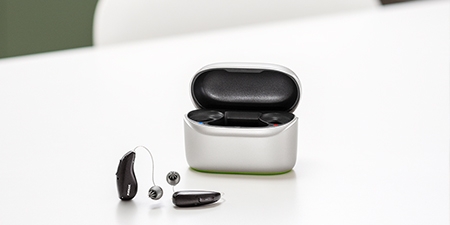What Are the Pros and Cons of Cheap Hearing Aids

What Are the Pros and Cons of Cheap Hearing Aids
15 min
Published July 14, 2025
With such a wide array of price points for hearing aids, consumers often have difficulty making a buying decision. In fact, people on the market for a hearing device often wonder if the higher price is really justified. Should they just go with a cheaper alternative? Understandably so, a lower price point can be very attractive, especially to those working with a smaller budget. After all, a hearing aid is a hearing aid, right? Unfortunately, it turns out that's wrong.
So to help you find the answer to the question of whether cheap hearing aids will be good enough to meet your needs, let's go into some detail about how hearing aids differ from one another. Once you learn about the various options available in the marketplace, you will be able to decide whether paying more for an advanced hearing device is worth the investment.
Types of Hearing Aids
Based on the technology used to build hearing aids, three main types of devices are personal sound amplification products (PSAPs), analog and digital hearing aids. Although PSAPs are the most affordable, unfortunately, they are not designed for those suffering from hearing loss.
- PSAPs often come with fewer features and benefits and may not amplify hearing at all. In addition, PSAPs do not compensate for hearing impairment and therefore are unlikely to meet the needs of those with major hearing loss.
- Analog hearing aids are priced slightly higher, but their sound quality is significantly better than PSAPs.
- Digital hearing aids cost more than analogs, but you can expect even better sound quality and user experience, as they give you the ability to modify sound waves.
According to another categorization, hearing devices can be either behind-the-ear (BTE), receiver-in-the-ear (RITE), and in-the-ear (ITE).
Depending on your lifestyle needs and specific type of hearing loss, your hearing professional or audiologist will likely recommend the device type and brand most likely to suit your needs.
What makes behind-the-ear (BTE) hearing aids unique is the placement of the battery compartment, controls, and microphone. All three components sit behind the ear with a clear tube connecting to the earmold. BTE hearing aids are appropriate for people with mild to severe hearing loss.
Receiver-in-the-canal (RIC) hearing aids are quite similar to BTE but are even more discreet. RIC is equipped with a nearly invisible tube connecting the casing to a receiver. Both of these components sit inside the ear canal. RIC hearing aids come in various colors and are also suitable for mild to severe hearing loss.
In-the-canal (ITC) hearing aids sit inside the ear canal in a plastic shell and are custom-made to fit your ear canal. Another variation of this type of device is the completely-in-the-canal (CIC) style that is even smaller and less visible. ITC hearing aids are best for moderate to severe hearing loss, while CIC is designed for mild to moderate hearing loss.
Advantages of Cheap Hearing Aids
Now that you have a good idea of the different types of hearing devices available, let's dive into the advantages and disadvantages of lower-priced hearing devices.
Cheap hearing aids are inexpensive
Undoubtedly, the most significant benefit of basic models is that they cost less. For those needing sound amplification for both ears, the savings over advanced models is quite substantial. Keep in mind, however, that lower-cost devices have fewer channels, which is a definite disadvantage. On the other hand, hearing aids with more channels are more finely tuned and therefore more likely to help correct your hearing loss, including age-related hearing loss.
Built with wireless capability
Also, many cheap hearing aids are built with wireless capability, which means that you can synchronize your device settings. Some of the lower-priced models can also include remote control, which enhances user experience.
While cheap hearing aids do not typically have Bluetooth capability, most of them have a built-in t-coil that allows you to link to loop systems in shops or movie theaters. If you are familiar with loop systems, you know that built-in loops will enable you to connect to TVs, PCs, and some home phones.
Often made by reputable manufacturers
A cheap hearing device does not necessarily mean a poorly made product. On the contrary, reputable manufacturers often produce different models at various price points to make their products affordable to a wide array of consumers.
Disadvantages of Cheap Hearing Aids
Cheap hearing aids are often low-quality imports
We cannot deny, however, that not all cheap hearing aids are of sound quality. Unfortunately, the competition is fierce, and it is easy to fall prey to cheap knockoffs and other low-quality imports. Therefore, if you are considering purchasing hearing devices at the lower end of the price spectrum, we encourage you to do your research and not make your decision solely based on price. Instead, take functionality and features into consideration in addition to the price.
Lower sound quality
Unfortunately, the sound quality of basic models is less sophisticated, which means that they are not as helpful in environments we refer to as "demanding," such as crowded places and social events. In addition, these devices don't have as many microphones, so their sound amplification is much more generalized, amplifying everything around you instead of focusing on one area. Why is this a problem? Fewer microphones can make it hard to hear speech in noisy environments.
Fewer programs make it harder to hear in noisy environments
Another drawback of lower-cost devices is that they have fewer programs, and some may require you to change programs and adjust the volume manually. All this is not to say that basic cheap hearing aids are not suitable for anyone. If, for instance, you spend most of your time at home or in a quiet environment, it's not likely that you will need multiple programs. A simple device may do a fine enough job to facilitate your one-on-one conversations and offer a cost-effective solution for your hearing loss.
What is the Bottom Line?
Ultimately, the answer to the question of whether cheap hearing aids are worth it depends on what you want from your hearing aids. While the cost-savings are undeniable with low-cost hearing devices, you should adjust your expectations accordingly about user experience, ease of use, and sound quality. After all, it should not surprise you that high-price, more advanced devices are built with more innovative technology, resulting in better user experience and consumer satisfaction. For instance, more advanced devices are equipped with feedback cancellation and wind noise reduction programs, and they may have specific programs to relieve tinnitus symptoms by playing soothing sounds.
Buying hearing devices can certainly be a hefty investment whether you are looking for a device at a lower or higher price point. So should you choose a high-end model with enhanced sound quality and more programs than you may need or a more basic model that might not have all the features you want?
Here are some additional points to consider to help you make the best possible decision:
- Make sure the hearing aid you are purchasing is an FDA-approved device and labeled FDA-registered.
- Make sure the company offers a money-back guarantee during a risk-free trial
- Consider investing in a digital hearing aid as they offer more complex programming
- Look for hearing aids that offer noise reduction and preferably wind noise reduction. While all hearing aids can reduce background noise, the degree to which they do this differs.
- Check if the hearing aids you are considering purchasing have directional microphones. Directional microphones make a big difference to your ability to hear in environments with a lot of background noise.
- Don't forget forget about rechargeable batteries. Some hearing aids have rechargeable batteries. Hearing aids built with rechargeable batteries are much easier to maintain, eliminating the need to change the battery regularly
In summary, basing your decision on price alone may not be the best way to approach your hearing aids purchase. Instead, you should consider the above points, such as features, functionality, and ease of use, to ensure you make a wise investment.
Remember, you can also rely on the advice of your audiologist and ask about new hearing aids and devices that become available. Book an appointment with the knowledgeable staff at AudioNova, if you feel overwhelmed by the vast number of options and need help finding a hearing solution that improves your ability to hear and communicate.




